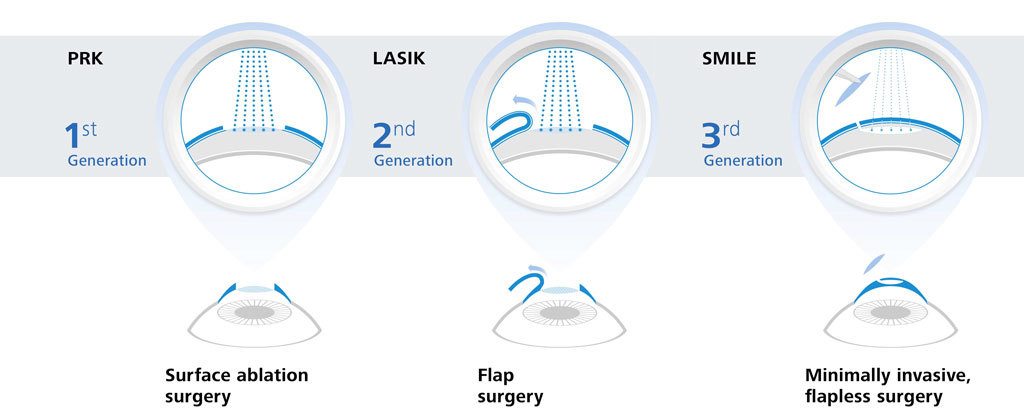What Are The Differences And Resemblances In Between SMILE Eye Surgery And LASIK And PRK?
What Are The Differences And Resemblances In Between SMILE Eye Surgery And LASIK And PRK?
Blog Article
Recommended Web-site -Ryberg Tang
If you've been thinking about SMILE eye surgery, you may wonder how it stacks up against LASIK and PRK. Each procedure has its very own set of advantages and factors to consider. From quicker recuperation times to possible dangers, there are crucial differences you need to know prior to making a decision. Recognizing these differences will aid you make an informed selection that aligns with your particular requirements and expectations. Interested to recognize even more concerning how these procedures contrast in detail? Go on discovering to obtain an extensive understanding of SMILE, LASIK, and PRK.
SMILE Eye Surgery Review
If you're considering SMILE eye surgery, you'll discover it to be a minimally intrusive treatment with a fast recuperation time. During SMILE (Small Incision Lenticule Extraction), a laser is used to produce a tiny, exact cut in the cornea to eliminate a little piece of cells, improving it to remedy your vision. This varies from LASIK, where a flap is produced, and PRK, where the outer layer of the cornea is totally removed.
Among the key benefits of SMILE is its minimally intrusive nature, causing a faster healing procedure and less pain post-surgery. The healing time for SMILE is reasonably fast, with several clients experiencing enhanced vision within a day or two. This makes it a preferred choice for those looking for a convenient and reliable vision correction procedure. Additionally, SMILE has been shown to have a reduced threat of completely dry eye syndrome contrasted to LASIK, making it a positive choice for individuals concerned regarding this prospective side effect.
Differences In Between SMILE, LASIK, and PRK
When contrasting SMILE, LASIK, and PRK eye surgeries, it is essential to understand the unique techniques made use of in each treatment for vision modification.
SMILE (Tiny Cut Lenticule Removal) is a minimally invasive procedure that includes developing a little laceration to draw out a lenticule from the cornea, reshaping it to fix vision.
LASIK (Laser-Assisted In Situ Keratomileusis) involves producing a thin flap on the cornea, making use of a laser to reshape the underlying cells, and after that rearranging the flap.
PRK (Photorefractive Keratectomy) gets rid of the external layer of the cornea before reshaping the cells with a laser.
The major distinction depends on the method the cornea is accessed and treated. please click the next website is flapless, making it a good alternative for people with thin corneas or those associated with contact sporting activities. LASIK offers quick aesthetic recuperation due to the flap creation, however it might position a greater danger of flap-related problems. PRK, although having a much longer recuperation period, avoids flap-related issues completely.
Recognizing these variances is essential in choosing the most appropriate procedure for your vision improvement demands.
Advantages And Disadvantages Contrast
To review the benefits and drawbacks of SMILE, LASIK, and PRK eye surgical procedures, it's important to consider the specific advantages and prospective limitations of each treatment. Laser Eye Surgery Cost uses the advantage of a minimally intrusive procedure, with a smaller incision and potentially quicker recuperation time contrasted to LASIK and PRK. It also lowers the risk of completely dry eye post-surgery, an usual side effect of LASIK. Nevertheless, SMILE may have limitations in dealing with greater degrees of myopia or astigmatism compared to LASIK.
website link supplies quick visual healing and very little pain throughout the treatment. It's extremely efficient in treating a large range of refractive errors, consisting of nearsightedness, hyperopia, and astigmatism. Yet, LASIK lugs a threat of flap difficulties, which can influence the corneal structure.
PRK eye surgery, while not as prominent as LASIK, avoids developing a corneal flap, decreasing the risk of flap-related issues. It's suitable for people with slim corneas or uneven corneal surfaces. Nevertheless, PRK has a longer recovery time and may involve much more pain during the healing procedure.
Conclusion
So, when it involves choosing in between SMILE, LASIK, and PRK, think about it like picking the best set of footwear. SMILE is like a sleek, comfortable pair of sneakers - quick and simple.
LASIK is more like trendy high heels - flashy and quickly, yet with some prospective dangers.
PRK resembles strong treking boots - trusted and long lasting, yet calling for a bit more effort and time.
Eventually, the very best choice relies on your private needs and choices.
